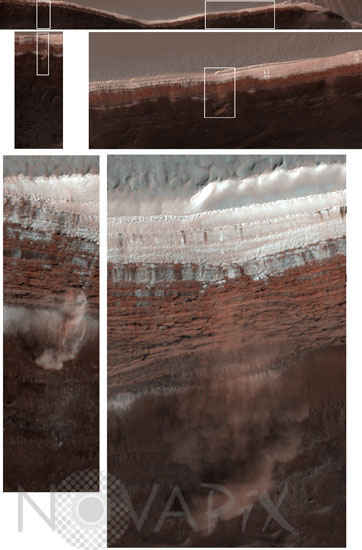Photo Agency - Astronomy - Space - Nature

Mars: avalanches on North Polar Scarps
author: NASA/JPL-Caltech/Univ. of Arizona/Novapix
reference: a-mar11-00050
Image Size 300 DPI: 13 * 20 cm
Amazingly, this image has captured at least four Martian avalanches, or debris falls, in action. It was taken on February 19, 2008, by the High Resolution Imaging Science Experiment (HiRISE) camera on NASA's Mars Reconnaissance Orbiter. The image to the top shows the context of where these avalanches occurred, with white boxes indicating the locations of the more detailed image portions. All images are false color. Material, likely including fine-grained ice and dust and possibly including large blocks, has detached from a towering cliff and cascaded to the gentler slopes below. The occurrence of the avalanches is spectacularly revealed by the accompanying clouds of fine material that continue to settle out of the air. The largest cloud traces the path of the debris as it fell down the slope, hit the lower slope, and continues downhill, forming a billowing cloud front. This cloud is about 180 meters (590 feet) across and extends about 190 meters (625 feet) from the base of the steep cliff. The scarp in this image is on the edge of the dome of layered deposits centered on Mars' north pole. From top to bottom this impressive cliff is over 700 meters (2300 feet) tall and reaches slopes over 60 degrees. The top part of the scarp, is still covered with bright (white) carbon dioxide frost which is disappearing from the polar regions as spring progresses. The upper mid-toned (pinkish-brownish) section is composed of layers (difficult to see here) that are mostly ice with varying amounts of dust. The darkest deposits below form more gentle slopes, less than 20 degrees, and are mainly composed of two materials: mid-toned layers, possibly ice-rich, that form small shelves, and more mobile, wide-spread, sand-sized dark material. The upper, steepest section, which appears highly fractured due to blocks pulling away from the wall, is the likely source zone for the falls. The precise trigger mechanism is not yet known, although the disappearance of the carbon dioxide frost, the expansion and contraction of the ice in response to temperature differences, a nearby Mars-quake or meteorite impact, and vibrations caused by the first fall in the area, are all possible contributors. The image was taken at a local Mars time of 1:05 PM and the scene is illuminated from the west with a solar incidence angle of 70 degrees, thus the sun was about 20 degrees above the horizon. At a solar longitude of 34.0 degrees, the season on Mars is northern spring.
Keywords for this photo:
2008 - ASTRONOMY - AVALANCHE - CARBON DIOXIDE - CLIFF - HIRISE - MARS - MARS RECONNAISSANCE ORBITER - MRO - PLANET -
Contact : Stéphane Aubin +33-(0)9-51-26-53-76
© Novapix - All rights reserved


